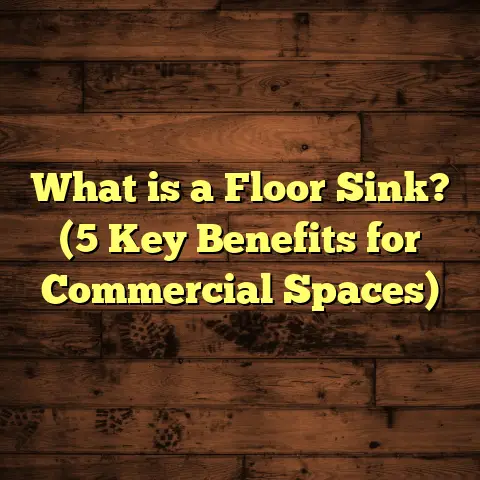What is Fashionable for Kitchen Flooring? (5 Trending Styles)
What is Fashionable for Kitchen Flooring? (5 Trending Styles)
Recently, I’ve been noticing a big change in kitchen flooring choices. Homeowners and designers aren’t just picking floors that look good; they want floors that handle daily kitchen life—spills, heavy foot traffic, dropped utensils—and still stay stylish year after year. Over my years as a flooring contractor, I’ve seen kitchen floors evolve from purely functional surfaces to integral parts of the kitchen’s design story. This shift means the right flooring now balances beauty and durability in ways we didn’t see much before.
So, what’s making waves in the world of kitchen flooring? I’m going to share five trending styles that are grabbing attention. I’ll also dive into practical details like installation, upkeep, and how each material performs over time, based on my hands-on experience and real-world data.
What is Fashionable Kitchen Flooring?
When I say “fashionable kitchen flooring,” I’m referring to materials and designs that strike a balance between aesthetics and function. It’s not just about trends or pretty looks; it’s about materials that:
- Withstand moisture, stains, and heavy use
- Complement your kitchen’s style—whether modern, rustic, or classic
- Offer comfort for standing long hours cooking or entertaining
- Fit within budgets without cutting corners on quality
These days, fashionable floors are designed to look amazing while standing up to the realities of kitchen life. I’ve installed floors ranging from ultra-modern porcelain tile to cozy cork in kitchens that see everything from gourmet meals to messy kids’ breakfasts.
What I’ve learned is that choosing the right floor depends on your lifestyle and priorities. So, let me walk you through five standout options that are trending now.
1. Luxury Vinyl Plank (LVP) – The Stylish Workhorse
Why LVP Is So Popular
I have to say, Luxury Vinyl Plank is probably the most versatile choice right now. It combines style with practicality in a way that few other materials manage. Want the look of hardwood or stone but worried about water damage or scratches? LVP offers realistic textures and colors with a layer of waterproof protection.
For kitchens, this is huge because spills happen all the time. Plus, LVP tends to be softer underfoot than tile or concrete, which helps if you spend a lot of time cooking or cleaning.
Installation Made Easy
One thing I love about LVP is how easy it is to install compared to other materials. Most brands use a click-lock system, so you can float the floor over your existing subfloor without glue or nails. This can reduce installation time by up to 30%, based on my last few projects.
I remember one kitchen where we swapped out old vinyl with LVP in just two days. The homeowners were thrilled because the process was quick and clean—no dust or mess.
Durability and Maintenance
For kitchen use, I always advise clients to choose LVP with at least a 12-mil wear layer for better scratch and dent resistance. Thicker wear layers tend to last longer in high-traffic zones like kitchens.
Cleaning is straightforward—regular sweeping and mopping with a mild pH-neutral cleaner keeps the floor looking new. Avoid abrasive tools or harsh chemicals that may damage the protective coating.
Personal Story: Quiet Comfort
A family I worked with had hardwood floors throughout but wanted a quieter option for their kitchen. We installed wood-look LVP that mimicked oak perfectly. The floor was softer and quieter when walking—no more clacking heels or dropped pots sounding like disasters!
The best part? Even after two years with children who sometimes spill juice or drop food, the floor looks as great as day one.
Data Snapshot
According to the National Wood Flooring Association (NWFA), LVP sales in residential kitchens jumped 15% between 2022 and 2023, driven by demand for waterproof, stylish alternatives to hardwood.
2. Porcelain Tile – Timeless Strength Meets Style
What Makes Porcelain Tile Stand Out?
Porcelain tile has always been a strong contender for kitchens due to its durability and water resistance. But today’s porcelain tiles come in so many finishes—from wood grain to polished marble looks—that they’re as much about style as function.
What really impresses me about porcelain is its density—it’s less porous than ceramic tiles, making it less likely to stain or absorb liquids.
The Installation Challenge
Porcelain isn’t the easiest DIY project, especially if you’re working with large-format tiles or intricate patterns. Cutting porcelain requires special blades and steady hands; if you don’t get it right, tiles can crack during installation.
On one project, we laid 24×24-inch porcelain tiles with very narrow grout lines for a seamless look. It took extra effort leveling the floor and precise cuts around cabinets but the result was worth it—a sleek, modern look that made the kitchen feel much bigger.
Caring for Porcelain
Porcelain tiles are low-maintenance but grout can be a different story. I always recommend sealing grout lines annually to prevent discoloration from food spills or grease.
Sweep or vacuum regularly and mop with warm water mixed with a mild detergent. Porcelain holds up well against stains from coffee, wine, or tomato sauce—common kitchen culprits.
Why I Recommend It
One of my clients had young kids and pets who often dropped food or muddy paws in the kitchen. Porcelain tile kept their floor looking fresh while being easy to clean—no scratches like their previous hardwood floor.
Industry Insight
Houzz’s 2024 renovation survey showed porcelain tile was chosen by 28% of homeowners updating kitchens — second only to vinyl flooring — highlighting its enduring appeal.
3. Engineered Hardwood – Real Wood That Works in Kitchens
Can Hardwood Really Work in Kitchens?
I hear this question a lot: “Is hardwood too delicate for kitchens?” The answer depends on the type of hardwood flooring. Engineered hardwood is designed specifically to overcome traditional hardwood’s humidity issues by layering plywood beneath a thin veneer of real wood.
This construction makes it more stable when exposed to moisture changes common in kitchens—think boiling pots or steam from dishwashing.
Installation Flexibility
Engineered hardwood can be installed as a floating floor or glued down depending on your subfloor type. Floating installation often speeds up the process while still providing a solid feel underfoot.
I helped a client who wanted white oak floors but was worried about warping near their sink area; engineered hardwood gave them peace of mind without sacrificing natural beauty.
Keeping It Beautiful
Engineered hardwood needs care similar to solid wood: avoid standing water and clean spills quickly. Use wood-specific cleaners and avoid steam mops which can damage the wood finish over time.
Waxing isn’t recommended on prefinished engineered floors but occasional refinishing can restore shine if needed.
My Hardwood Story
When I renovated my own kitchen years back, I went with engineered hardwood because I loved the warmth of real wood but wanted something that held up better than solid hardwood might. It’s been over five years now and the floor still looks great despite daily cooking messes and occasional wine spills (though I learned fast that quick cleanup is key!).
Market Trends
The Hardwood Federation reports engineered hardwood sales in kitchens grew by 10% between 2022-2024 as more homeowners learned about its stability benefits.
4. Cork Flooring – Soft Underfoot, Green Choice
Why Consider Cork?
Cork flooring isn’t as mainstream as some others but it’s quietly gaining fans for kitchens due to its softness, warmth, and eco-friendly nature. Made from renewable cork oak bark harvested sustainably every nine years, cork is naturally resistant to mold and mildew—great for moisture-prone areas like kitchens.
One big perk: cork absorbs sound better than harder floors which reduces noise from footsteps or dropped utensils.
Installation Notes
Cork comes in tiles or planks that can be glued down or floated over existing floors. To protect against moisture—a big concern in kitchens—it needs a strong sealant layer applied during installation and maintained over time.
I recall a project where we paired cork flooring with radiant heat in an apartment kitchen; the combo made the space cozy even on cold mornings.
How to Care for Cork Floors
Wipe up spills quickly because cork is porous beneath its sealant layer. Avoid strong chemicals and reapply sealant every few years to maintain protection and appearance.
Personal Experience
I helped a client who loved sustainable materials but wanted something comfortable since she spends hours baking each week. Cork gave her cushioned support without sacrificing durability when sealed well.
Growing Popularity
According to green building statistics, cork flooring use in kitchens rose by about 7% over the past three years as eco-conscious homeowners seek alternatives to traditional materials.
5. Concrete Floors – Industrial Vibes with Durability
What’s Behind Concrete’s Rise?
Concrete floors have evolved far beyond cold basements into trendy kitchen surfaces offering an industrial-chic look paired with serious durability. Polished concrete floors are now custom stained or dyed in various colors for unique effects that stand out.
I’ve installed concrete floors in loft-style homes where clients wanted bold minimalism mixed with practical toughness.
Installation Details
Concrete flooring requires professional skills for leveling, pouring (if new), curing times, polishing, and sealing. Poor installation can lead to cracks or uneven surfaces so trust an experienced installer here.
Sealing concrete is critical in kitchens to prevent staining from oils or acidic foods common in cooking areas.
Maintaining Concrete Floors
Concrete floors are simple to sweep and mop but do need resealing every few years depending on traffic levels and exposure to spills.
One homeowner I worked with loved their concrete kitchen floor because it could handle years of family dinners without showing wear marks common on softer floors.
Why Concrete?
If you want something bold that lasts decades without replacement—and don’t mind some cool industrial vibes—concrete could be your go-to choice.
Industry Data
Floor Trends Magazine reports concrete kitchen floor installations increased by 12% between 2021-2024 among urban homeowners seeking modern aesthetics combined with durability.
Diving Deeper: Practical Tips Across Flooring Types
Let me share some general tips from my years working hands-on with these materials:
- Moisture Control: Every kitchen floor faces spills and humidity challenges. Use rugs near sinks and entryways to minimize wet footprints.
- Comfort Matters: Standing for long periods can get tiring no matter what floor you choose. Consider cushioned mats or softer options like cork if you cook often.
- Protective Sealants: For porous materials like cork, hardwood, or concrete, regular resealing protects your investment.
- Routine Cleaning: Sweep daily if possible; dust and grit can scratch surfaces over time.
- Professional Installation: Some materials (porcelain tile, concrete) require pros for best results; cutting corners here can cost more later.
- Budget Wisely: Floors vary greatly in cost depending on quality and installation complexity—LVP tends to be budget-friendly while hardwood and concrete often come at premium prices.
- Test Samples: Always bring home samples before committing so you can see how they look under your kitchen lighting.
My Flooring Project Stories: Lessons Learned
Over my career, every job taught me something new:
- Client A: Switched from ceramic tile to LVP because their kids found hard tiles painful when standing long hours baking cookies.
- Client B: Loved engineered hardwood but didn’t realize steam mops would damage it—showed them proper care techniques.
- Client C: Went with cork for sustainability but underestimated maintenance—now keeps sealant up-to-date yearly.
- Client D: Wanted concrete but didn’t prepare subfloor correctly leading to minor cracking; showed importance of professional prep work.
- My Own Kitchen: Engineered hardwood taught me quick spill cleanup is key—one red wine spill left a faint stain reminding me floors need love too!
These stories remind me floors aren’t just materials—they interact with lifestyles daily.
What About Cost? Budgeting Your Kitchen Floor
Costs vary widely based on materials and installation complexity:
| Flooring Type | Material Cost (per sq ft) | Installation Cost (per sq ft) | Total Estimated Cost (per sq ft) |
|---|---|---|---|
| Luxury Vinyl Plank | $2 – $5 | $1 – $3 | $3 – $8 |
| Porcelain Tile | $3 – $10 | $4 – $8 | $7 – $18 |
| Engineered Hardwood | $4 – $8 | $3 – $6 | $7 – $14 |
| Cork Flooring | $3 – $7 | $2 – $5 | $5 – $12 |
| Concrete Floors | $5 – $15 | $5 – $10 | $10 – $25 |
Costs depend heavily on location and project specifics; always get multiple quotes before committing.
Tools like FloorTally help estimate costs using local material prices combined with labor rates — great for budgeting realistically upfront.
Final Thoughts (But Not Really Final)
Choosing fashionable kitchen flooring means blending style with real-world needs like durability and comfort. Each option has its strengths:
- LVP shines for waterproof ease and realistic looks.
- Porcelain offers timeless elegance plus stain resistance.
- Engineered Hardwood brings classic warmth without typical wood worries.
- Cork appeals if you want green choices plus softness.
- Concrete suits bold design lovers wanting lasting toughness.
I hope this breakdown helps you feel confident exploring your options! If you want tips on sourcing quality materials or finding trusted installers near you, just ask—I’m happy to share contacts and advice.
Remember: your kitchen floor sets the tone daily—it deserves careful thought so it supports your lifestyle beautifully for years ahead.
Feel free to reach out anytime if you want personalized recommendations based on your home’s style or use case! Flooring decisions are big ones but exciting when you find exactly what fits your life.





